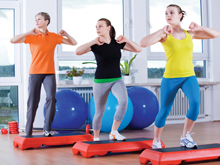Health Topics
-
Healthy Living
-
|
|
September 2011
|
| Walk for a Healthy Heart |
| Vidya Gajapati Raj Singh |
| |
 |
Cardio fitness is crucial in increasing the performance level of a person in any sport or fitness activity.A healthy body leading to a healthy mind should be the priority for all of us.
Physiology tells us that the heart pumps the blood through the body and this makes its working one of the most important aspects of the human body functions. We need to develop cardiovascular fitness to ensure that the heart stays strong and powerful and will work to its maximum potential. |
The term Cardio fitness refers to improving the overall fitness of the heart and lungs.This in turn gives these organs the ability to take oxygen and essential nutrients to the proper muscles more efficiently.
Aerobics for the Heart
Any aerobic activity that improves and strengthens your heart and lung capacity is considered to be cardiovascular. Out of the several equally effective options available, you must choose the ones that are suitable to your age and ability. The choice includes jogging, running or speed training, whether it be bicycling, walking, a combination of jog / walk or swimming or aerobic classes. A plethora of cardio machines line gym floors all across the country, EFX, steppers, ski machines and stationary bicycles.
Facts
- Cardio activity is absolutely imperative to our health and well-being.
- One needs to do a minimum of 40 min to 1 hour of cardio everyday.
- Take a day's rest in a week.
- Only after 30 minutes does the body become aerobic and get into the calorie-burning mode. It is merely anaerobic before that, for the first 30 mins, when it uses oxygen to fuel itself.
- If you have time on a particular day for only one type of workout, choose to do some cardio.
- A combination of several types of cardio workouts is also highly beneficial as different muscles come into play while doing different workouts.
| Kenneth Cooper considered to be the ‘Father of aerobics’, in 1960s, coined the word ‘aerobics’. He spoke of LSD, (Long Slow Distance) and advocated that exercising at a steady speed, over a distance would give the maximum benefit to the heart and lungs. Sudden bursts of speed were excellent for a person who was in training for a sport. But this steady, even paced workout would bring the maximum results.He emphasized that while jogging or walking, it would be ideal to raise the heart beat to a level where the cardio effect could kick in and then to keep it raised for at least 30 to 40 mins and aim eventually towards that one hour mark. |
Walk For Life
It was about one million years ago that Homo sapiens stood up on its own two feet and began to walk, it has not stopped ever since. Walking has evolved into the most natural movement that a human being can do.Putting one foot in front of the other to move forward and swinging your arms in tandem comes naturally to all of us. One of the enjoyable aspects of walking, as a fitness routine, is that you can do it at your own time and at your own pace. If you need quiet time to yourself, you could walk alone and look at it as a form of meditation, a chance to reflect on your day and your life. If you feel the need for companionship, you could walk with a friend or a group of friends and get the added benefit of friendship and camaraderie.
Walking facts
- Benefits–Cardiovascular, respiratory and muscular fitness
- Muscles worked – Legs, Abs, shoulders and arms
- Calories burnt – 100 cal for every one mile at a speed of 15 min per mile
- Walking is one form of exercise that puts the least strain on your bones and muscles and is very low impact as well
- Strengthens the heart, increases lung capacity, lowers cholesterol, improves blood circulation, relieves stress, improves balance, controls weight, creates high energy, helps decrease the risk of diabetes, heart attack and stroke
How to get the most out of your walk
- Begin and end your walk, with a few minutes of gentle stretching.
- Keep a good posture while walking. Head up, shoulders thrown back, spine held erect and stomach tucked in.
- Swing your arms while walking, to help propel yourself forward.
- Breathe freely through your nose and mouth, as you need to get plenty of oxygen into your body.
- Gradually increase the pace and distance until you are able to do 6.4 km/4 miles in one hour. A brisk half-hour to one-hour walk, five days a week is the ideal goal.
- Hold your stomach muscles pulled in as much as you can. This is an isometric exercise, to improve your abs muscles.
- If you need to increase resistance and enhance your calorie burn, you could either carry a light weight in your hands, or wear a backpack that is lightly weighted.
|
Points to remember
- You need to invest in a good pair of walking shoes.
- Try to find a quiet place to walk, if possible.
- A treadmill is an excellent alternative to outdoor walking.
- While walking, make sure that the heel of your foot strikes the ground first and then the whole foot.
- Keep a pace that is comfortable for you.
- Choose a time of the day that suits you i.e. early morning or evening.
- Wear loose comfortable clothes that allow for free movement.
- Different ways of walking include slow, fast, brisk and power walking.
|
|
Vidya Gajapati Raj Singh is a sports and fitness enthusiast, and popular columnist based in chennai
|
|
> |